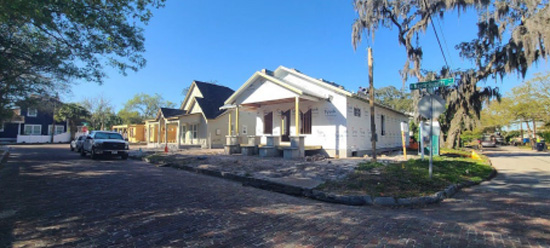Tampa City Council Will Hear New Code to Protect Tampa Heights 'Unique Urban Character'
The group is calling on supporters to sign a petition before the Thursday meeting.
Creative Loafing, Justin Garcia on Mon, Jun 20, 2022 at 3:47 pm

The corner of Tampa Heights' N Massachusetts Avenue and W Braddock Street in February 2021. Photo by Ray Roa
A city code amendment written by the Tampa Heights Civic Association (THCA) to help protect the neighborhood from the consequences of unchecked development will be heard at city council this week.
THCA submitted the code amendment last year, and cited concerns about the city not doing enough to protect the character and structure of the neighborhood for the past several years. At city council on Thursday, June 23, council will hear the group's amendment.
"After years of unfulfilled promises from the City of Tampa to protect the neighborhoods, THCA wrote its own code to protect the neighborhood's unique urban character and promote walkable development," the group wrote in a news bulletin.
The code seeks to establish more protections for the Tampa Heights area by designating it as a district that would garner more protection under city rules.
The "purpose and intent" section of the amendment says that of the entire area of Tampa Heights should be established as an "overlay district" which means it would have specific protections and guidelines to help guide future development and to, "promote the unique character of the area" along with the integrity of the district.
The amendment aims to achieve this by calling on the city to use design standards that ensure development in the area will, "be more compatible with the surrounding historic residential neighborhood," the amendment draft reads.
The group says that the amendment is not meant as a cure-all for incompatible development practices, but that it is a stop-gap measure while THCA works on more ways to protect the neighborhood, as it faces increasing challenges from development.
"Especially since 2015, the rate of uncomplimentary development has exploded when it should have been protected by regulations the City committed to enacting," the executive summary for the amendment reads.
"Such development creates conditions that are dangerous to pedestrians, harms the welfare of surrounding homeowners, and detracts from the traditional urban fabric of the neighborhood."
According to THCA, the Tampa Heights National Historic District was created in 1995. In 2000, a local Historic District was created with slightly enlarged boundaries, and overlay design standards were implemented to protect the historic district. But a lot of the Tampa Heights area was left out.
"Only a fraction of the neighborhood was included due to the lack of concentration of historic structures in the western half of Tampa Heights," THCA wrote. "However, a few select historic buildings in this area were included."
Most other remaining historic homes were not included in the district. THCA regularly requested additional protections from the City for the entire neighborhood since the foundation of the Historic District in 2000.
After repeated tries, the city told members of THCA to write the potential protections themselves. The result, after two years of working on it, is the amendment being presented to council on Thursday.
The group is calling on supporters to sign a petition before the Thursday meeting.
THCA included a list of "key points" to the amendment, which are as follows:
- Front doors should be oriented towards the street frontage
- Incentivize use of alleys for vehicles access to limit the impact on sidewalk pedestrian safety
- Driveway size and location standards to limit impact on pedestrian circulation.
Preserve front yard green space through driveway standards. Incentivize front porch construction through setback relief Allow Accessory Dwelling Units (ADUs) on all residential properties, which promotes affordable housing and income streams for homeowners - Preserve on-street parking for residents and guests
- Reduce commercial parking minimums to incentivize redevelopment and induce walkability
- Commercial parking shall be placed on the side or rear of buildings, not the front, to encourage pedestrian access
- Require bike parking at large commercial properties
- Take action toward affordability through making Tampa Heights less car-reliant



